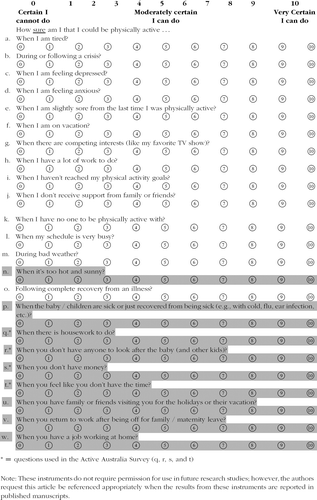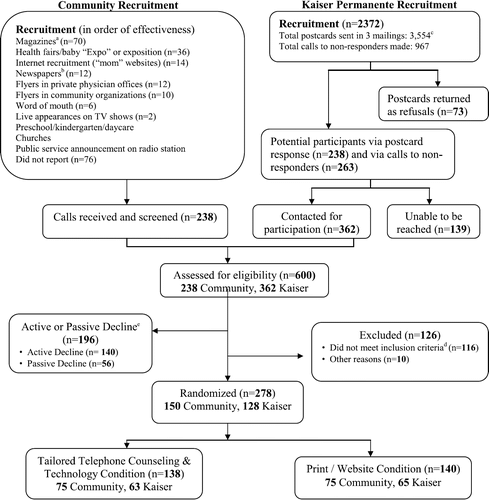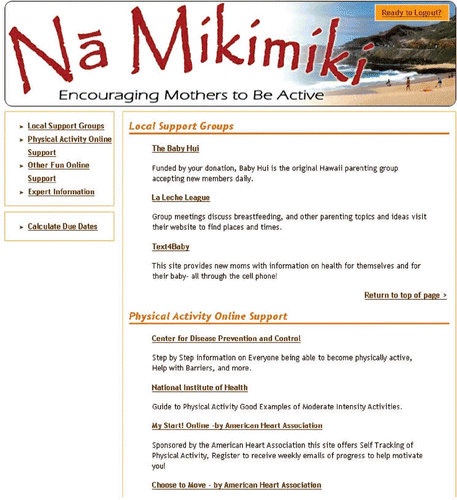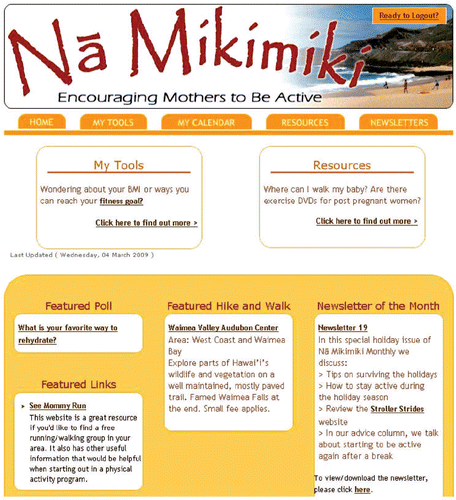Abstract
During the postpartum period, ethnic minority women have higher rates of inactivity/under-activity than white women. The Nā Mikimiki (“the active ones”) Project is designed to increase moderate-to-vigorous physical activity over 18 months among multiethnic women with infants 2–12 months old. The study was designed to test, via a randomized controlled trial, the effectiveness of a tailored telephone counseling of moderate-to-vigorous physical activity intervention compared to a print/website materials-only condition. Healthy, underactive women (mean age = 32 ± 5.6 years) with a baby (mean age = 5.7 ± 2.8 months) were enrolled from 2008–2009 (N = 278). Of the total sample, 84% were ethnic minority women, predominantly Asian–American and Native Hawaiian. Mean self-reported baseline level of moderate-to-vigorous physical activity was 40 minutes/week with no significant differences by study condition, ethnicity, infant's age, maternal body mass index, or maternal employment. Women had high scores on perceived benefits, self-efficacy, and environmental support for exercise but low scores on social support for exercise. This multiethnic sample's demographic and psychosocial characteristics and their perceived barriers to exercise were comparable to previous physical activity studies conducted largely with white postpartum women. The Nā Mikimiki Project's innovative tailored technology-based intervention and unique population are significant contributions to the literature on moderate-to-vigorous physical activity in postpartum women.
INTRODUCTION
Becoming a mother is a significant transition in a woman's life. While this is a positive experience for most, significant decrements can occur in several health promoting behaviors, including physical activity (PA) (CitationAlbright, Maddock, & Nigg, 2005, Citation2009; CitationOlson et al., 2003; CitationHaas et al., 2005). In women, demographic factors associated with inactivity or reductions in physical activity over time include having a child and being employed outside the home (CitationBrown & Trost, 2003; CitationScharff et al., 1999). Results from a survey of multiethnic postpartum women living in Hawaii indicated that 68% were more inactive or irregularly active following childbirth, with no differences by race (CitationAlbright, Maddock, & Nigg, 2005). However, many studies have found ethnic minority women (mostly African-Americans) to be at higher risk of inactivity or at lower levels of moderate-to-vigorous physical activity (MVPA) than whites during pregnancy and postpartum periods (CitationHe & Baker, 2005; CitationSchmidt et al., 2006). Thus, as young adult women, especially ethnic minorities, transition into parenthood, they are at high risk for physical inactivity or significant reductions in previous levels of PA (CitationBrown & Trost, 2003; CitationLeslie et al., 2001).
Several intervention studies have encouraged the initiation and maintenance of regular physical activity in postpartum women, some in combination with diet modification, to achieve weight loss (CitationFahrenwald et al., 2004; CitationFahrenwald & Walker, 2003; CitationOstbye et al., 2009; CitationChang, Nitzke, & Brown, 2010; CitationFjeldsoe, Miller, & Marshall, 2010; CitationMiller, Trost, & Brown, 2002; CitationLewis et al., 2011). As the majority of previous studies have been conducted with white or African-American women (CitationOstbye et al., 2008; CitationChang, Nitzke, & Brown, 2010; CitationFahrenwald et al., 2004; CitationFjeldsoe, Miller, & Marshall, 2010; CitationMiller, Trost, & Brown, 2002), little is known about the effectiveness of physical activity interventions for postpartum women from other races/ethnic minority backgrounds.
The behavioral intervention developed for this study was based on theoretical constructs derived from social cognitive theory (SCT) and the Transtheoretical Model (TTM), which have been used in many home-based and self-management programs (CitationMiller, Trost, & Brown, 2002; CitationAlbright et al., 2005; CitationMarcus, Ciccolo, & Sciamanna, 2009). In addition to incorporating theoretical constructs, the intervention incorporated findings from qualitative (n = 79; Albright, Maddock, & Nigg, 2005) and quantitative pilot studies (n = 20; Albright, Maddock, & Nigg, 2009) conducted with mothers of infants living in Hawaii. These preliminary studies provided insight into multiethnic mothers' barriers to physical activity, such as lack of spouse support for childcare and their receptivity to intervention strategies (i.e., goal setting). Results indicated that women were receptive to scheduled telephone calls, used e-mail daily, and were very familiar with the Internet (e.g., visited websites to obtain information about their own health, to correspond/learn from other new mothers, and to obtain health and childhood development information about their babies). Telephone (including text messages) and Internet contacts have been effective components of interventions for increasing PA in a range of populations (CitationFjeldsoe, Miller, & Marshall, 2010; CitationLawler et al., 2010; CitationWantland et al., 2004). They are particularly effective and convenient for populations that are unable or not interested in joining exercise groups, such as new mothers who may be too busy to join a group exercise program, do not have childcare, or do not want their infants exposed to infectious agents. The authors used the findings from a pilot study and results from other mediated physical activity intervention studies with postpartum ethnic minority women to design a multi-component intervention that was tailored to meet the needs of multiethnic mothers of infants less than 12 months of age (CitationAlbright, Maddock, & Nigg, 2005, Citation2009; CitationOstbye et al., 2009; CitationChang, Nitzke, & Brown, 2010; CitationFjeldsoe, Miller, & Marshall, 2010).
The aim of the authors in this study (named “The Nā Mikimiki Project,” translated as “the active ones” in Hawaiian) was to test the effectiveness of an 18-month tailored telephone counseling and technology (TCT) PA intervention designed to initiate and maintain MVPA compared to a PA print/website materials-only (P/WM) comparison condition. This article describes the rationale, study design, recruitment/intervention methods, and study measures—the latter of which were adapted for use with this population. The sample's characteristics were also compared to those reported in previous PA interventions with postpartum women.
MATERIALS AND METHODS
Sample Size and Eligibility
Prior to beginning the study a sample size of 266 women (133 per condition) was set so as to allow for up to 25% attrition by the 18-month final assessment, resulting in a minimum final sample size of 200 (100 per condition). the authors determined that this sample size would allow detection of an effect size of d = 0.4 (medium), assuming a two-sided alpha = 0.05 and 80% power. Based on pilot data (CitationAlbright, Maddock, & Nigg, 2009), the effect size of d = 0.4 was estimated as consistent with a minimal detectable difference between conditions of approximately 30 minutes of MVPA per week.
Eligibility criteria were designed to limit enrollment to healthy, sedentary, or under-active women with infants 2–12 months old, and to ensure that those with relevant health problems had clearance from their physician to participate (). Of the 600 women screened over the telephone, 196 declined to participate and 126 were excluded, 92% of the latter for not meeting the eligibility criteria ().
Study Population, Recruitment, and Randomization
Between April 2008 and October 2009, 278 postpartum women were recruited from two sources: (1) community-based campaigns or advertisements, and (2) contacting eligible members of a local health care organization (Kaiser Permanente: KP; ).
The community-based recruitment efforts included print and multimedia campaigns. Parenting magazine ads, a booth at a baby expo, and newspaper ads were the most successful strategies of the community recruitment efforts (). KP mailed recruitment letters describing the study to 3,554 eligible women, including a postcard to be mailed back to indicate interest in the study. If postcards were not returned within 2 weeks of the mailing, KP staff called non-responders to determine interest in joining the study ().
TABLE 1 Eligibility Criteria
This study protocol was approved by the University of Hawaii's Committee on Human Studies and the KP Institutional Review Board. All participants signed informed consent forms, and a Data Safety Monitoring Board oversaw recruitment, retention, and severe adverse events over the course of the study.
Participants were randomized using a blocked approach (CitationFriedman, Furberg, & Demets, 1998), stratified on recruitment source (KP/community) and on parity (primiparous/multiparous; i.e., four strata) to ensure treatment conditions were balanced within each stratum.
Study Conditions
P/WM Condition
The authors conceptualized this condition as an “information only” condition that provided women with information on the benefits of physical activity via a P/WM condition website with links to Internet resources for exercise (e.g., American Heart Association's “Choose to Move” website, ).
Tailored tct intervention
The TCT intervention addressed key mediators of physical activity, including: personal factors of self-regulatory behavioral skills and self-efficacy to do regular PA (CitationFahrenwald & Walker, 2003; CitationLombard et al., 2009; CitationHinton & Olson, 2001a, Citation2001b), social support for physical activity from family and friends (CitationMiller, Trost, & Brown, 2002; CitationMcIntyre & Rhodes, 2009), and environmental factors (e.g., how to find “stroller friendly” parks).
Telephone counseling was designed to provide regular, credible, individualized counseling that incorporated theoretically derived constructs, using culturally sensitive techniques (CitationResnicow et al., 1999). Counseling was delivered by trained counselors familiar with motivational interviewing techniques and the use of problem-solving strategies to help the mothers initiate and maintain a safe physical activity program. Each TCT participant received approximately 17 health educator-initiated telephone or e-mail contacts over 12 months. The average duration of these telephone calls was 12.6 minutes.
To encourage self-monitoring during the intervention, TCT participants were given a pedometer (New Lifestyles NL-1000) to track physical activity via step counts (Tudor–Locke et al., 2002). Participants reported accumulated daily steps to the counselor during their contacts, with 10,000 steps per day being the ultimate goal.
The TCT condition's website was designed to provide information on parks with paved paths for a stroller and other PA resources, as well as skills-building tips via newsletters ().
Retention Methods
Participants in both conditions were given a total of $60 in gift cards for participation in the study. This amount was divided up into $10 each for participation in the baseline and 6-month assessments, with $20 each for participation in 12- and 18-month assessments. During the course of the study all participants were mailed small gifts (e.g., water bottle) and birth day cards.
Measurement Schedule and Instruments
Questionnaires, accelerometers, exercise logs, and anthropometric data were collected at baseline and a maximum of 4 time points during follow-up (at 1, 3, 6, 12, or 18-months post-baseline, ). The questionnaires included standardized instruments used in previous studies with women (e.g., Active Australia Survey). However, as described below, the authors adapted several psychosocial instruments to include key barriers or benefits unique to new mothers.
Sociodemographic Characteristics
The baseline survey assessed age, ethnicity/race, education, lactation status, etc., and characteristics of the infant ().
Anthropometric Measurements
Weight (Detecto scale, Model 448, Webb City, MO), height, and sitting height (Seca Height Rod Model 222, Hanover, MD) were measured in light indoor clothing, without shoes or heavy clothing, following standard protocols (CitationFrisancho, 1990). Sitting height was used to derive leg length which has been linked to nutritional and environmental factors (e.g., deprivation) in childhood (CitationWebb et al., 2008) as well as with increased risk of some chronic diseases in women (CitationWeitzman et al., 2010; CitationOsuch et al., 2010).
TABLE 2 Time Points of Study Measures
Primary Outcomes: Assessment of MVPA
The Active Australia Survey (AAS) was used to assess frequency (number of 10-minute sessions) and duration (minutes) of walking (“for recreation, exercise, or to get from place to place”), moderate intensity physical activity (“like non-competitive tennis”), and vigorous PA (“that makes you breathe hard like aerobics, jogging”) in the last week. A PA summary score was created as sum of minutes of walking and MVPA, with vigorous activity time weighted by two (CitationBrown & Bauman, 2000). This survey was administered at baseline, 6, 12, and 18-months post-baseline (). The AAS survey has good test-retest reliability (CitationBrown et al., 2004), good validity with objective accelerometer measured physical activity (CitationBrown et al., 2008), and is sensitive to change in intervention trials (CitationReeves et al., 2010). Respondents were also asked to report minutes per weekday and weekend day they spent sitting while traveling, at work, watching TV, etc. (CitationMarshall et al., 2010).
Accelerometer
A Lifecorder EX downloadable accelerometer (New Lifestyles NL-2200, Inc.) was worn by all participants for 7 days (during waking hours) (). While wearing the accelerometer participants also kept an exercise log noting the duration of exercise lasting more than 10 minutes, and amount of time spent exercising when the device was not worn (e.g., swimming). Data from the accelerometer and exercise logs will be reported separately.
TABLE 3 Baseline Sociodemographic Variables by Study Condition
Psychosocial Measures
The psychosocial measures were adapted to include questions that addressed issues unique to mothers with young infants, as described below. Psychosocial measures are listed in Appendix 1 with the questions tailored to new mothers highlighted in gray.
Self-efficacy was assessed using an instrument designed to assess self-confidence to overcome barriers to PA (e.g., bad weather, etc.). A higher score represented a higher level of self efficacy (CitationBandura, 1986; CitationGarcia & King, 1991; CitationAlbright et al., 2005). The original 14-item instrument was modified to include nine additional questions. Five questions were based on previous studies (CitationAlbright, Maddock, & Nigg, 2005, Citation2009) and addressed issues such as: self-efficacy to exercise when no one is available to care for her infant/children or to exercise when the infant/children are sick. Four of the questions were from an Australian PA intervention study with mothers of young children (CitationMiller, Trost, & Brown, 2002). The internal consistency for the modified instrument (Cronbach's alpha) was 0.93, which was comparable to the alpha of 0.89 for the original 14-item survey.
Perceived barriers and benefits of PA were assessed using scales developed for previous PA studies (CitationHeesch, Masse, & Dunn, 2006; CitationSallis et al., 1999). A higher score represents a higher frequency for which a barrier prevented MVPA (e.g., lack of time) and a stronger agreement a respondent had that a specific benefit would be achieved by regular MVPA. Both scales were adapted by including benefits such as sleeping better at night and having fun with baby/children while exercising, and barriers such as exercising when her baby/children were sick and living in a neighborhood that had no sidewalks to accommodate a stroller (Appendix 1).
The original barriers instrument had five subscales: (1) aversiveness—containing five questions to measure responses such as “exercise is boring”; (2) excuses—comprised of four questions to measure responses such as “lack of time”; (3) demands—with three questions gauging work/family demands; (4) worries—containing six questions measuring responses such as “self-conscious about looks”; and (5) inconveniences—comprised of nine questions gauging answers such as “no sidewalks.” A factor analysis showed that the excuses and demands questions loaded onto one factor, and the motherhood questions loaded onto the inconvenience and worries subscales. Cronbach's alphas for these subscales ranged from 0.64 to 0.77 with an overall alpha for the entire scale of 0.86, which is comparable to the scale without the motherhood-specific questions (i.e., 0.84).
Factor analysis of the revised benefits questions showed two subscales of physiological benefits (e.g., gain muscle) and psychological benefits (e.g., improved self-esteem), as previously published (CitationHeesch, Masse, & Dunn, 2006). The Cronbach's alphas were 0.93 for the physiological scale and 0.85 for the psychological scale, an improvement from 0.75 for the original subscales.
Social support was assessed using an adapted version of the Sallis family/friend support for participation in exercise scales (CitationSallis et al., 1987). Participants reported support on a 5-point Likert scale (1 = never, 5 = very often), the mean of all items was calculated, with higher values indicating more social support. Based on previous work with postpartum women (CitationAlbright, Maddock, & Nigg, 2005, Citation2009), this scale was modified to include items such as providing childcare so mother could exercise (3 questions in Appendix 1). The Cronbach's alpha was 0.88 for the modified scale and 0.89 for the original scale.
Participants rated positive and negative components of their environment by reporting exercise equipment used at home, and specific features of the built environment that facilitate/hamper efforts to be physically active in their neighborhood (CitationSallis et al., 1997). Home equipment was measured using the sum from a list of 18 dichotomous (yes/no) items (e.g., exercise videotapes/DVDs). Neighborhood environment included perceptions of how safe it was to walk in the mother's neighborhood (1 = very unsafe, 5 = very safe), and perceived household income of her neighborhood. Neighborhood built environment features included yes/no responses about whether specific infrastructures or facilities, such as sidewalks, were available in her neighborhood. Previous research has shown the perceived environment scales to be adequately reliable (test–retest r = 0.68–0.89) and related to self-reported physical activity (CitationSallis et al., 1997, Citation2007; CitationKing et al., 2006). Again, based on previous research with this population (CitationAlbright, Maddock, & Nigg, 2005, Citation2009), the scale was modified by adding equipment that would assist a new mother's ability to be physically active, including strollers, infant carrier, etc. The Cronbach's alphas for these subscales were lower (0.52–0.63) largely due to the considerable diversity of facilities for physical activity across neighborhoods on Oahu.
The Edinburgh Postnatal Depression Scale was used to assess postpartum depression symptoms using 10 questions (range 0–30). It has been shown to have good sensitivity (86%) and specificity (78%) with a positive predictive value of 73% (CitationCox, Holden, & Sagovsky, 1987). A score ≥10 indicates possible postpartum depression. It has been tested in low-income and minority women and found to be a practical and efficient tool for identifying women at risk for postpartum depression (CitationHanna, Jarman, & Savage, 2004).
The Ethnocultural Identity Behavioral Index was used to assess cultural identity via participation in ethnocultural traditions (e.g., dances, language: Yamada, Marsella, & Yamada, 1998; CitationMarsella et al., 1998). Respondents identified the ethnocultural group they most strongly identified with and then rated on a 7-point scale (1 = never, 7 = always) how often they followed that group's customs and cultural practices.
Statistical Analyses
SAS software (version 9.1) was used for all analyses. Characteristics of the study sample were summarized using descriptive statistics, such as means, medians, standard deviations, and inter-quartile ranges for continuous measures and frequency distributions for categorical measures. The authors used exploratory principal components analyses to check subscale structure for multidimensional instruments, examined scree plots to determine the number of principal components, and used orthogonal rotation to determine item loading. After identifying subscales, the authors assessed the internal consistency of the items using Cronbach's alpha (CitationNunnally & Berstein, 1994). Differences between the randomized conditions were tested using the Wilcoxon rank-sum test and Pearson's chi-square test of independence. In addition, multivariable linear and logistic regression analyses were used to test for differences between study conditions after adjusting for baby's age, number of children (1 vs. >1), and BMI. Sociodemographic variables were adjusted for if they differed significantly between study conditions or if they were identified a-priori as being important potential confounders. The authors used a Kruskal–Wallis test and Pearson correlation to examine the relationship of MVPA with demographic characteristics.
RESULTS
A total of 138 women were randomly assigned to the TCT-tailored condition and 140 to the P/WM–materials only condition (). No significant differences were observed in baseline sociodemographic characteristics between the two randomly assigned conditions ().
Baseline Physical Activity Level
Differences between conditions in self-reported minutes per week of PA at baseline () were not statistically significant and the adjusted results from linear and logistic regression analyses were consistent with the unadjusted results. Median time spent walking was 30 minutes per week, and the median for all activities combined was 40 minutes per week. Few women (14%) met national recommendations for MVPA; however, because active women were ineligible for the study, no women were expected to meet recommendations at baseline. It is possible that the discrepancy for these 14% was caused by differences in women's responses to the brief telephone screening questions compared to the more detailed baseline MVPA written survey questions. Furthermore, no differences in baseline PA were found by ethnicity (χ2(6) = 4.27, p = .64), working status (χ2(2) = 2.67, p = .26), age of infant (r = −0.01, p = .85), or BMI (r = 0.07, p = .22).
Mothers reported spending the most time sitting (about 3 hours per day) while they held or fed their baby (). In general the women reported sitting at work for 2 ± 2 hours per day. However, when stratified by employment status, women with no paid employment reported sitting less “at work” (0.2–0.4 hours) than those who were employed part or full-time (1.5–3.6 hours; p < .0001). Mean hours per day of sitting during work for women working full-time was similar across both conditions (TCT = 3.4 ± 2.0 hours, P/WM = 3.6 ± 2.3 hours; p = .58). However, sitting time at work for those working part-time was significantly different in the TCT (1.5 ± 1.7 hours) versus the P/WM (2.8 ± 2.5 hours) condition (p < .03). Women in the P/WM condition reported sitting significantly longer while traveling to and from work (about 15 minutes; p < 0.03 in the unadjusted analyses, with a comparable result of p < 0.01 in the adjusted analysis), but the times spent on other sedentary activities were not significantly different across the two conditions.
Compliance with wearing the accelerometer at baseline was excellent, with 91.3% of participants wearing the device and returning it with retrievable data. Somewhat fewer (86.3%) completed a PA log on the days they wore the accelerometer.
Psychosocial Measures
No significant differences were observed by study condition in the baseline levels for the psychosocial variables (), and the adjusted results from linear and logistic regression analyses were comparable to the unadjusted results. Almost all of the women were in preparation or action stages (33% and 64%, respectively), perhaps reflective of their interest in joining the study. On average the mothers had 6–7 types of personal exercise equipment (out of a list of 18), and their neighborhoods were fairly conducive to PA, with an average of 8 (out of 12) supportive characteristics (e.g., sidewalks, street lights).
In contrast, support from family/friends for the mom's physical activity was fairly low (mean = 1.9 = “rarely”). The barriers rated the most frequently as preventing a mother from being active were lack of time (68%) and family demands (66%). Several perceived benefits of PA were endorsed by almost all of the participants including: reduce risk of disease (98%), feel better about body (97%), and be a role model for children (95%).
Mean scores for postpartum depression symptoms were fairly low (means of 6.0 and 6.7 respectively for the TTCT and P/WM conditions out of a total of 30), with no significant difference by study condition (). Using the Edinburgh cutpoint of 10, 21% of all participants were possibly depressed or at risk for postpartum depression (no difference by condition).
TABLE 4 Baseline Physical Activity and Sitting Time by Study Condition
TABLE 5 Baseline Psychosocial Variables by Study Condition
DISCUSSION
Developing effective MVPA interventions that prevent reductions in physical activity and encourage reductions in sedentary behaviors have the potential to prevent future chronic diseases in vulnerable populations, such as ethnic minority postpartum women, who are at increased risk for being inactive or not meeting national recommendations for optimal physical activity. The Nā Mikimiki Project was designed to test the efficacy of a PA intervention designed to be culturally sensitive to minority women in Hawaii and tailored to meet the needs of women who had an infant between 2 and 12 months of age.
Over 18 months, recruitment mailings were sent to over 3,500 KP members and almost 1,000 members were telephoned who had an infant 2–12 months in age. By conservative estimates, almost 10,000 additional women were reached with print/media advertisements. Thus, considerable time and effort was made to reach, recruit, and randomize 278 eligible new mothers into a PA study. However, as in most research studies, the new mothers who volunteered to join an 18-month PA study and agreed to complete complex study assessments, may have stronger motivations to become more active than new mothers who did not volunteer.
The Nā Mikimiki Project is one of only three physical activity intervention studies to include a significant proportion of ethnic minority postpartum women, with two of these three studies (Mothers in Motion: MIM, and Active Mothers Postpartum: AMP) recruiting primarily African-American women (CitationChang, Nitzke, & Brown, 2010; CitationOstbye et al., 2009). The proportion of African-Americans in these samples (52% and 45%, respectively) was considerably lower than the proportion of minority women (largely Asians, Native Hawaiians, and other Pacific Islanders) in the Nā Mikimiki sample (84%). The Nā Mikimiki sample was similar to samples in other studies for age of mother, marital status, percent primiparous, and number of children (CitationFjeldsoe, Miller, & Marshall, 2010; CitationChang, Nitzke, & Brown, 2010; CitationOstbye et al., 2009; CitationNorman et al., 2010).
However, these studies differed in factors that could be associated with new mothers' motivation to be more active, including lactation, working status, educational attainment, BMI, and infant's age. The rates of lactation ranged from 36% for AMP (CitationOstbye et al., 2008) to 80% in Nā Mikimiki, the highest proportion of the published physical activity studies. About one third of the sample (36%) was unemployed, which was similar to the proportion in MIM (41%) (CitationChang, Nitzke, & Brown, 2010). However, it was lower than the unemployed rate in the Australian Mobile Mums study (67%) (CitationFjeldsoe, Miller, & Marshall, 2010) and higher than in AMP (18%: Ostbye et al., 2008). Similarly, the present sample's education distribution was most similar to that of the AMP sample (CitationOstbye et al., 2008), but it was higher than the educational level in MIM, which was a sub-sample recruited from the Women, Infants, and Children (WIC) nutrition program for lower socio-economic status women (CitationChang, Nitzke, & Brown, 2010).
The mean BMI of 28 kg/m2 in this sample was similar to that reported in Mobile Mums (27 kg/m2) but lower than that reported in AMP (33 kg/m2: Ostbye et al., 2008; Fjeldsoe, Miller, & Marshall, 2010). The percentage of the sample with BMI > 30 kg/m2 was 33.8% in Nā Mikimiki, which is lower than in AMP (47%); but the latter was a weight loss study that only recruited women with a BMI > 25 kg/m2 prior to pregnancy (CitationOstbye et al., 2008).
The AMP sample had the youngest infants (entry age of 6 weeks: Ostbye et al., 2008) and MIM had the oldest mean infant age of 12 months (CitationChang, Nitzke, & Brown, 2010). With the exception of Moms on the Move (CitationFahrenwald & Walker, 2003), this study and the other four studies recruited women with infants who were unlikely to be walking independently (CitationNorman et al., 2010; CitationFjeldsoe, Miller, & Marshall, 2010; CitationOstbye et al., 2008; CitationChang, Nitzke, & Brown, 2010).
Although the measurement of baseline physical activity level varied, minutes of walking/MVPA appear to be similar across postpartum PA studies. Mobile Mums reported a median of 40 minutes of walking per week for one of their study conditions (CitationFjeldsoe, Miller, & Marshall, 2010). AMP reported a mean of 39 minutes of MVPA per day (273 minutes MVPA per week) (CitationOstbye et al., 2008), and the results of the present study were 30 minutes per week of walking and 40 minutes per week of total MVPA.
Three physical activity intervention studies have used the Edinburgh Postpartum Depression measure at baseline. The mean value of 6.3 was comparable to that reported in AMP (6.6), and both were lower than the mean (7.4) reported in Norman's study (CitationNorman et al., 2010; CitationOstbye et al., 2008). In general, the prevalence of postpartum depression as defined by the Edinburgh survey is comparable with that reported in other studies of healthy, postpartum women that have used this instrument (CitationHorowitz et al., 2010; CitationAustin et al., 2010; CitationRoss et al., 2011).
Limitations
The present sample of postpartum women may not be representative of all new mothers in Hawaii or the United States, given that this sample consisted of women who were interested in becoming more active. Also, it is very difficult to compare/contrast the sample's characteristics with other women in Hawaii or the United States, because the authors could not obtain demographic data on postpartum women from the Hawaii census or American Community Survey, especially background information on those who do not currently exercise regularly.
CONCLUSIONS
The time and effort to recruit 278 eligble new mothers into the study was substantial; however, the women who enrolled were very compliant to baseline assessments. This sample of multiethnic women face similar barriers to being physically active as have been reported in previous studies with postpartum women.
The Nā Mikimiki Project's innovative use of tailored technology (website, e-mails) combined with theoretically-derived telephone counseling and its unique population composed of minority women who have, to date, been under-represented in previous PA intervention research (i.e., Asian-Americans, Native Hawaiians/Pacific Islanders, and women with a mixed race heritage) is a significant contribution to the literature on PA in postpartum women. The study's final results include both objective and subjective measures of PA, and determine which key sociodemographic and psychosocial factors are related to change in PA over an initial 12-month period and maintenance of change over 6 months.
Notes
Trial Registration: Clinical Trials.gov number NCT00810342.
The project described was supported by NIH Award Numbers CA115614 and CA115614–03S1 from the National Cancer Institute. The content is solely the responsibility of the authors and does not necessarily represent the official views of the National Cancer Institute or the National Institutes of Health.
The authors would like to thank and show sincere appreciation to the following individuals who contributed to the implementation and completion of this study's intervention and assessments: Lillian Cross, Katie M. Heinrich, PhD, Trina Orimoto, Leslie Welsh, Regina Suyderhoud, Anniken Rose, Sonya Niess, D. Chad Johnson, Dominique Freire, Elise Davis, Peter Hinely, Yeehwa G. Daida, Ada Demleitner, Valentyna S. Pishchalenko, Jennifer L. Elia, MPH, Ray Browning, PhD, Rebecca E. Lee, PhD, Fedor Lurie, MD, Heather Hausenblas, PhD, and all the postpartum women who volunteered for the study.
Note. 1Women with twins were ineligible, but women with adopted children were eligible.
2To make the community sample comparable to the Kaiser sample with respect to access to medical care (i.e., insured), all subjects were required to have health insurance. To include a range of income levels in the sample, low-income women who qualified for health coverage via the MedQUEST program (Department of Health and Human Services funded medical coverage) through Kaiser or other providers were eligible; 10.1% of the sample reported having MedQUEST insurance.
3Women with a BMI between 18.5 and 40 kg/m2 were eligible. Severely underweight women and women with a Level III obesity classification (BMI >40) were excluded because they often have medical and psychological issues that are beyond the scope of this study.
4Exception is skin cancer.
5Includes atrial fibrillation, myocardial ischemia, history of myocardial infarction, and/or atherosclerotic cardiovascular diseases (e.g., stroke).
6Women unable to complete two in-person visits were ineligible. Each participant was also required to provide her mailing address, an e-mail address, and her telephone number.
7Women with these medical histories/conditions/symptoms were required to obtain their physician's written approval clearing her to increase her physical activity prior to enrollment.
8Severe complications during pregnancy or the postpartum period, such as: preterm delivery (<36 weeks, baby weight <5 lbs), toxemia, preeclampsia, or postpartum depression.
Note. * = Chi square test for differences in proportions; t test for differences in means.
* = minutes of moderate + vigorous activities combined with latter given double the weight.
¥ = Tests of differences between study conditions: Chi Square test for differences in proportions, t-test for differences in means.
†Adjusted for baby age, 1 versus >1 child, and BMI.
* = p value for test of difference between two conditions (e.g., t-test).
¥ = a higher value of the variables equals a stronger or higher rating of that construct, e.g., support, self-efficacy, benefits, etc.
# = instrument was modified, questions tailored to postpartum women were added.
†Adjusted for baby age, 1 versus >1 child, and BMI.
REFERENCES
- Albright , C. L. , Maddock , J. E. and Nigg , C. R. 2005 . Physical activity before pregnancy and following childbirth in a multiethnic sample of healthy women . Women & Health , 42 : 95 – 110 .
- Albright , C. L. , Maddock , J. E. and Nigg , C. R. 2009 . Increasing physical activity in postpartum multiethnic women in Hawaii: Results from a pilot study . BMC Womens Health , 9 : 4
- Albright , C. L. , Pruitt , L. , Castro , C. , Gonzalez , A. , Woo , S. and King , A. C. 2005 . Modifying physical activity in a multiethnic sample of low-income women: One-year results from the IMPACT (Increasing Motivation for Physical ACTivity) Project . Annals of Behav Med , 30 : 191 – 200 .
- Austin , M.-P. , Hadzi–Pavlovic , D. , Priest , S. , Reilly , N. , Wilhelm , K. , Saint , K. and Parker , G. 2010 . Depressive and anxiety disorders in the postpartum period: How prevalent are they and can we improve their detection? . Archives of Women's Mental Health , 13 : 395 – 401 .
- Bandura , A. 1986 . Social foundations of thought and action: A social cognitive theory Englewood Cliffs , NJ : Prentice Hall. .
- Brown , W. J. and Bauman , A. E. 2000 . Comparison of estimates of population levels of physical activity using two measures . Aust N Z J Public Health , 24 : 520 – 5 .
- Brown , W. J. , Burton , N. W. , Marshall , A. L. and Miller , Y. D. 2008 . Reliability and validity of a modified self-administered version of the active Australia physical activity survey in a sample of mid-age women . Aust N Z J Public Health , 32 : 535 – 41 .
- Brown , W. J. and Trost , S. G. 2003 . Life transitions and changing physical activity patterns in young women . Amer J of Prev Med , 25 : 140 – 3 .
- Brown , W. J. , Trost , S. G. , Bauman , A. , Mummery , K. and Owen , N. 2004 . Test–retest reliability of four physical activity measures used in population surveys . J Sci Med Sport , 7 : 205 – 15 .
- Chang , M. W. , Nitzke , S. and Brown , R. 2010 . Design and outcomes of a mothers in motion behavioral intervention pilot study . J Nutr Educ Behav , 42 : S11 – 21 .
- Cox , J. L. , Holden , J. M. and Sagovsky , R. 1987 . Detection of postnatal depression. Development of the 10-item edinburgh postnatal depression scale . Br J Psychiatry , 150 : 782 – 6 .
- Fahrenwald , N. L. , Atwood , J. R. , Walker , S. N. , Johnson , D. R. and Berg , K. 2004 . A randomized pilot test of “moms on the move”: A physical activity intervention for WIC mothers . Annals of Behav Med , 27 : 82 – 90 .
- Fahrenwald , N. L. and Walker , S. N. 2003 . Application of the transtheoretical model of behavior change to the physical activity behavior of WIC mothers . Public Health Nursing , 20 : 307 – 17 .
- Fjeldsoe , B. S. , Miller , Y. D. and Marshall , A. L. 2010 . MobileMums: A randomized controlled trial of an SMS-based physical activity intervention . Ann Behav Med , 39 : 101 – 11 .
- Friedman , L. S. , Furberg , C. D. and Demets , D. L. 1998 . Fundamentals of Clinical Trials New York , NY : Spring Science-Business Media, LLC. .
- Frisancho , A. R. 1990 . Anthropmetric standards for the assessment of growth and nutritional status Ann Arbor , MI : The University of Michigan Press. .
- Garcia , A. W. and King , A. C. 1991 . Predicting long-term adherence to aerobic exercise: A comparison of two models . J of Sport and Exercise Psycho , 13 : 394 – 410 .
- Haas , J. S. , Jackson , R. A. , Fuentes–Afflick , E. , Stewart , A. L. , Dean , M. L. , Brawarsky , P. and Escobar , G. J. 2005 . Changes in the health status of women during and after pregnancy . J Gen Intern Med , 20 : 45 – 51 .
- Hanna , B. , Jarman , H. and Savage , S. 2004 . The clinical application of three screening tools for recognizing post-partum depression . Int J Nurs Pract , 10 : 72 – 9 .
- He , X. Z. and Baker , D. W. 2005 . Differences in leisure-time, household, and work-related physical activity by race, ethnicity, and education . J Gen Intern Med , 20 : 259 – 66 .
- Heesch , K. C. , Masse , L. C. and Dunn , A. L. 2006 . Using Rasch modeling to re-evaluate three scales related to physical activity: Enjoyment, perceived benefits and perceived barriers . Health Educ Res , 21 : i58 – 72 .
- Hinton , P. S. and Olson , C. M. 2001a . Postpartum exercise and food intake: The importance of behavior-specific self-efficacy . J Am Diet Assoc , 101 : 1430 – 7 .
- Hinton , P. S. and Olson , C. M. 2001b . Predictors of pregnancy-associated change in physical activity in a rural white population . Matern Child Health J , 5 : 7 – 14 .
- Horowitz , J. A. , Murphy , C. A. , Gregory , K. E. and Wojcik , J. 2010 . A community-based screening initiative to identify mothers at risk for postpartum depression . J Obstet Gynecol Neonatal Nurs , 40 : 52 – 61 .
- King , A. C. , Toobert , D. , Ahn , D. , Resnicow , K. , Coday , M. Riebe , D. 2006 . Perceived environments as physical activity correlates and moderators of intervention in five studies . Am J Health Promot , 21 : 24 – 35 .
- Lawler , S. P. , Winkler , E. , Reeves , M. M. , Owen , N. , Graves , N. and Eakin , E. G. 2010 . Multiple health behavior changes and co-variation in a telephone counseling trial . Ann Beh Med. , 39 : 250 – 7 .
- Leslie , E. , Fotheringham , M. J. , Owen , N. and Bauman , A. 2001 . Age-related differences in physical activity levels of young adults . Med Sci Sports Exerc , 33 : 255 – 8 .
- Lewis , B. A. , Martinson , B. C. , Sherwood , N. E. and Avery , M. D. 2011 . A pilot study evaluating a telephone-based exercise intervention for pregnant and postpartum women . J Midwifery Womens Health , 56 : 127 – 31 .
- Lombard , C. B. , Deeks , A. A. , Ball , K. , Jolley , D. and Teede , H. J. 2009 . Weight, physical activity and dietary behavior change in young mothers: Short term results of the HeLP-her cluster randomized controlled trial . Nutr J , 8 : 17
- Marcus , B. H. , Ciccolo , J. T. and Sciamanna , C. N. 2009 . Using electronic/computer interventions to promote physical activity . Br J Sports Med , 43 : 102 – 5 .
- Marsella , A. J. , Johnson , F. A. , Johnson , C. L. and Brennan , J. 1998 . Ethnic identity in second; (Nisei), third; (Sansei), and fourth; (Yonsei) generation Japanese Americans in Hawaii . Asian Am Pac Isl J Health , 6 : 46 – 52 .
- Marshall , A. L. , Miller , Y. D. , Burton , N. W. and Brown , W. J. 2010 . Measuring total and domain-specific sitting: A study of reliability and validity . Med and Sci in Sports and Exercise , 42 : 1094 – 102 .
- McIntyre , C. A. and Rhodes , R. E. 2009 . Correlates of leisure-time physical activity during transitions to motherhood . Women Health , 49 : 66 – 83 .
- Miller , Y. D. , Trost , S. G. and Brown , W. J. 2002 . Mediators of physical activity behavior change among women with young children . Am J Prev Med , 23 : 98 – 103 .
- Norman , E. , Sherburn , M. , Osborne , R. H. and Galea , M. P. 2010 . An exercise and education program improves well-being of new mothers: A randomized controlled trial . Phys Ther , 90 : 348 – 55 .
- Nunnally , J. C. and Bernstein , I. H. 1994 . Psychometric theory, , 3rd ed. New York , NY : McGraw-Hill, Inc. .
- Olson , C. M. , Strawderman , M. S. , Hinton , P. S. and Pearson , T. A. 2003 . Gestational weight gain and postpartum behaviors associated with weight change from early pregnancy to 1 y postpartum . Intl J of Obesity and Related Metabolic Disorders , 27 : 117 – 27 .
- Ostbye , T. , Krause , K. M. , Brouwer , R. J. , Lovelady , C. A. , Morey , M. C. Bastian , L. A. 2008 . Active mothers postpartum (AMP): Rationale, design, and baseline characteristics . J Womens Health (Larchmt) , 17 : 1567 – 75 .
- Ostbye , T. , Krause , K. M. , Lovelady , C. A. , Morey , M. C. , Bastian , L. A. Peterson , B. L. 2009 . Active mothers postpartum: A randomized controlled weight-loss intervention trial . Am J Prev Med , 37 : 173 – 80 .
- Osuch , J. R. , Karmaus , W. , Hoekman , P. , Mudd , L. , Zhang , J. , Haan , P. and Milucki , D. 2010 . Association of age at menarche with adult leg length and trunk height: Speculations in relation to breast cancer risk . Annals of Human Biology , 37 : 76 – 85 .
- Reeves , M. M. , Marshall , A. L. , Owen , N. , Winkler , E. A. and Eakin , E. G. 2010 . Measuring physical activity change in broad-reach intervention trials . J Phys Act Health , 7 : 194 – 202 .
- Resnicow , K. , Baranowski , T. , Ahluwalia , J. S. and Braithwaite , R. L. 1999 . Cultural sensitivity in public health: Defined and demystified . Ethn Dis , 9 : 10 – 21 .
- Ross , L. , Villegas , L. , Dennis , C.-L. , Bourgeault , I. , Cairney , J. Grigoriadis , S. 2011 . Rural residence and risk for perinatal depression: A Canadian pilot study . Archives of Women's Mental Health , 14 : 175 – 85 .
- Sallis , J. F. , Calfas , K. J. , Alcaraz , J. E. , Gehrman , C. and Johnson , M. F. 1999 . Potential mediators of change in a physical activity promotion course for university students: Project GRAD . Ann Behav Med , 21 : 149 – 58 .
- Sallis , J. F. , Grossman , R. M. , Pinski , R. B. , Patterson , T. L. and Nader , P. R. 1987 . The development of scales to measure social support for diet and exercise behaviors . Prev Med , 16 : 825 – 36 .
- Sallis , J. F. , Johnson , M. F. , Calfas , K. J. , Caparosa , S. and Nichols , J. 1997 . Assessing perceived physical environment variables that may influence physical activity . Research Qtly for Exercise and Sport , 68 : 345 – 51 .
- Sallis , J. F. , King , A. C. , Sirard , J. R. and Albright , C. L. 2007 . Perceived environmental predictors of physical activity over 6 months in adults: Activity counseling trial . Health Psychol , 26 : 701 – 9 .
- Scharff , D. P. , Homan , S. , Kreuter , M. and Brennan , L. 1999 . Factors associated with physical activity in women across the life span: Implications for program development . Women Health , 29 : 115 – 34 .
- Schmidt , M. D. , Pekow , P. , Freedson , P. S. , Markenson , G. and Chasan–Taber , L. 2006 . Physical activity patterns during pregnancy in a diverse population of women . J Womens Health (Larchmt) , 15 : 909 – 18 .
- Tudor–Locke , C. , Ainsworth , B. E. , Thompson , R. W. and Matthews , C. E. 2002 . Comparison of pedometer and accelerometer measures of free-living physical activity . Med Sci Sports Exerc , 34 : 2045 – 51 .
- Wantland , Portillo D.J. , Holzemer , C. J. , Slaughter , W. L. R. and McGhee , E. M. 2004 . The effectiveness of web-based vs. non-web-based interventions: A meta-analysis of behavior change outcomes . J Med Internet Res , 6 : e40
- Webb , E. A. , Kuh , D. , Pajak , A. , Kubinova , R. , Malyutina , S. and Bobak , M. 2008 . Estimation of secular trends in adult height, and childhood socioeconomic circumstances in three Eastern European populations . Econ Hum Biol , 6 : 228 – 36 .
- Weitzman , S. , Wang , C. , Pankow , J. S. , Schmidt , M. I. and Brancati , F. L. 2010 . Are meaures of height and leg length related to incident diabetes mellitus? The ARIc (Atherosclerosis Risk in Communities) study . Acta Diabetol , 47 : 237 – 42 .
- Yamada , A. M. , Marsella , A. J. and Yamada , S. 1998 . The ethnocultural identity behavior inventory . Asia Pac J Public Health , 1998 : 35 – 45 .
APPENDIX 1: Nā MIKIMIKI PROJECT QUESTIONNAIRES
Unique questions developed specifically for postpartum women highlighted in gray.
Social Support Survey
The next questions are about how other people may influence your physical activity or exercise.
During the past 3 months, how often have your FRIENDS, FAMILY OR MEMBERS OF YOUR HOUSEHOLD …
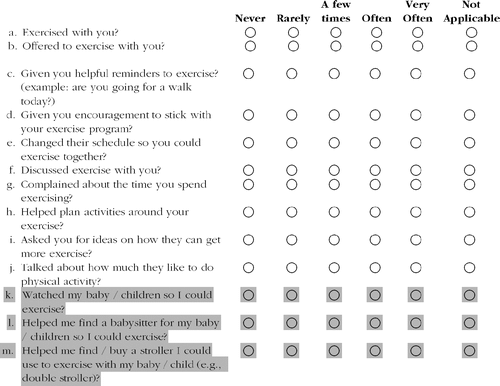
Perceived Environment Survey
Please indicate below which items you own or have access to and if you use that item regularly.
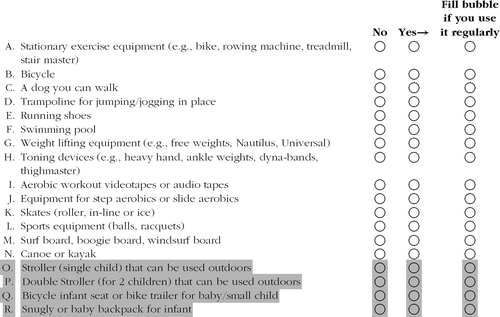
Barriers to Physical Activity Survey
How often do the following prevent you from being physically active? (please fill in a circle on each line )
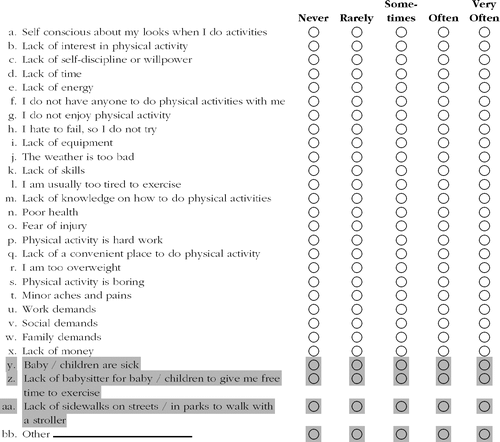
Benefits of Physical Activity Survey
Please indicate whether you agree/disagree with the following statements.
If I participate in regular physical activity or sports, then: (please fill in a circle on each line )
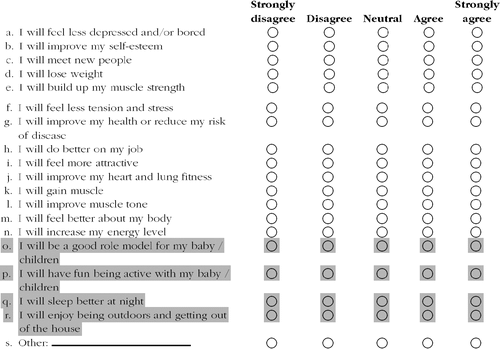
Self Efficacy to Overcome Barriers to Physical Activity
Many people report that it is more difficult to be physically active under some conditions than others. Please fill in a circle with a number between 0 and 10 to show how certain or sure you are that you could be physically active under EACH of the following conditions over the next 6 months. Please fill in a circle with a number for each of the items below using the following scale:
